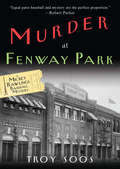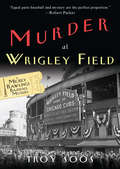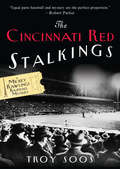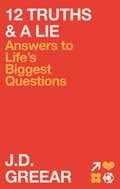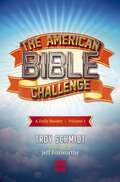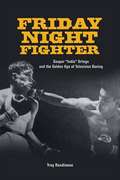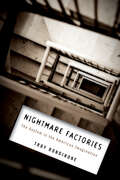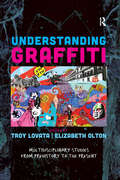- Table View
- List View
Murder at Fenway Park: A Mickey Rawlings Baseball Mystery (A Mickey Rawlings Mystery #1)
by Troy SoosA Red Sox rookie is accused of murder in the first Mickey Rawlings historical mystery &“that will leave readers eager for subsequent innings&” (Publishers Weekly). Boston, 1912. Fenway has just opened, Ty Cobb is a nationwide sensation, and rookie Mickey Rawlings has finally made it to the majors. But just when he sets foot inside the confines of the green monster, his all-star dreams come crashing down—Rawlings is fingered for the monstrous murder of his teammate Red Corriden. Sure, someone decided to use Red for batting practice. But just because Rawlings has fouled off a lot of balls in his time doesn&’t mean the cops have to be as blind as a rookie ump when it comes to his innocence. With no one watching his back, Rawlings has no choice but to switch his baseball cap for a sleuthing hat to clear his name. Otherwise, it&’s going to be a short season in the majors and a long one behind bars . . . &“Equal parts baseball and mystery are the perfect proportion.&” —Robert Parker &“Soos&’ delightful debut, mixing suspense, period detail and such legendary baseball greats as Cobb, Walter Johnson, Smokey Joe Wood and Tris Speaker, is a four-bagger.&” —Publishers Weekly
Murder at Wrigley Field: A Mickey Rawlings Baseball Mystery (A Mickey Rawlings Mystery #3)
by Troy SoosA historical mystery with &“first-rate wartime Chicago atmosphere&” and starring a ballplayer who &“turns double plays and solves murders with equal grace&” (Publishers Weekly). While the nation wages war against Germany in 1918, utility infielder Mickey Rawlings has been traded to the North Side of Chicago. He's batting a career high (a respectable .274) and the Cubs are in first place. For the first time in a long while Mickey is feeling financially secure enough to buy furniture. That's when his best friend—rookie Willie Kaiser—is shot dead right on the diamond. While the official explanation is "accidental death from a stray bullet," Mickey thinks someone's taken the anti-war sentiment too far. Between collapsing bleacher seats and pretzel sabotage in the stands, Mickey's search for answers takes him from silent movies to speakeasies to the stockyards. As long as he keeps fouling off clues, it's only a matter of time before a killer is caught in a rundown—or Mickey is tagged out permanently. &“[A] quietly effective portrait of wartime Chicago in the throes of painful German-baiting and on the verge of Prohibition.&”—Kirkus ReviewsPraise for the Mickey Rawlings Baseball Mysteries &“Full of life.&”—The New York Times Book Review &“A perfect book for the rain delay…a winner.&” —USA Today &“Delightful…period detail that will leave readers eager for subsequent innings.&”—Publishers Weekly
The Cincinnati Red Stalkings: A Mickey Rawlings Baseball Mystery (A Mickey Rawlings Mystery #5)
by Troy Soos"Equal parts baseball and mystery are the perfect proportion." --Robert Parker The Big Dead MachineIt's 1921, and journeyman infielder Mickey Rawlings finds himself on yet another team, the Cincinnati Reds, who everyone remembers for "winning" the 1919 World Series against the infamous Chicago Black Sox. In an effort to refurbish their image, Oliver Perrimen, a die-hard Reds fan cooks up a memorabilia exhibit of the 1869 Cincinnati Red Stockings, who went undefeated in a historic coast-to-coast romp. But before the tour can reach first base, someone strikes Ollie out with a well-placed bullet. Since murder seems to follow Mickey around like a hitting slump he can't quite quit, he starts snagging clues. Soon enough he finds his hands full with a forgotten murder, breaking and entering, and an angry girlfriend. But when the game of his own life is on the line, Mickey Rawlings is a born survivor. At least he hopes. . .Praise for the Mickey Rawlings Baseball Mysteries"Full of life." --The New York Times Book Review on Hanging Curve"A perfect book for the rain delay. . .a winner!" --USA Today on Murder at Fenway Park"Delightful. . .mixing suspense, period detail that will leave readers eager for subsequent innings." --Publishers Weekly on Murder at Fenway Park
Cadbury Schweppes: Capturing Confectionery (A)
by David J. Collis Troy Smith Toby StuartIn late 2002, global confectionery and beverage maker Cadbury Schweppes needed to decide whether or not to make an acquisition bid for Adams, an underperforming gum company which had been put up for sale by pharmaceutical giant Pfizer. Examining the decision from a strategic perspective, the (A) case provides brief histories of the two companies; traces the global confectionery industry, focusing especially on chocolate and gum; and details the analysis of the merger decision. The (B) case explores the specific identified synergies in-depth and provides an opportunity to judge their viability. The (C) and (D) cases conclude the story and update the case with issues facing the global confectionery leader in 2008.
Cadbury Schweppes: Capturing Confectionery (A)
by David J. Collis Troy Smith Toby StuartIn late 2002, global confectionery and beverage maker Cadbury Schweppes needed to decide whether or not to make an acquisition bid for Adams, an underperforming gum company which had been put up for sale by pharmaceutical giant Pfizer. Examining the decision from a strategic perspective, the (A) case provides brief histories of the two companies; traces the global confectionery industry, focusing especially on chocolate and gum; and details the analysis of the merger decision. The (B) case explores the specific identified synergies in-depth and provides an opportunity to judge their viability. The (C) and (D) cases conclude the story and update the case with issues facing the global confectionery leader in 2008.
Cadbury Schweppes: Capturing Confectionery (B)
by David J. Collis Troy Smith Toby StuartIn late 2002, global confectionery and beverage maker Cadbury Schweppes needed to decide whether or not to make an acquisition bid for Adams, an underperforming gum company which had been put up for sale by pharmaceutical giant Pfizer. Examining the decision from a strategic perspective, the (A) case provides brief histories of the two companies; traces the global confectionery industry, focusing especially on chocolate and gum; and details the analysis of the merger decision. The (B) case explores the specific identified synergies in-depth and provides an opportunity to judge their viability. The (C) and (D) cases conclude the story and update the case with issues facing the global confectionery leader in 2008.
Cadbury Schweppes: Capturing Confectionery (B)
by David J. Collis Troy Smith Toby StuartIn late 2002, global confectionery and beverage maker Cadbury Schweppes needed to decide whether or not to make an acquisition bid for Adams, an underperforming gum company which had been put up for sale by pharmaceutical giant Pfizer. Examining the decision from a strategic perspective, the (A) case provides brief histories of the two companies; traces the global confectionery industry, focusing especially on chocolate and gum; and details the analysis of the merger decision. The (B) case explores the specific identified synergies in-depth and provides an opportunity to judge their viability. The (C) and (D) cases conclude the story and update the case with issues facing the global confectionery leader in 2008.
Cadbury Schweppes: Capturing Confectionery (C)
by David J. Collis Troy Smith Toby StuartIn late 2002, global confectionery and beverage maker Cadbury Schweppes needed to decide whether or not to make an acquisition bid for Adams, an underperforming gum company which had been put up for sale by pharmaceutical giant Pfizer. Examining the decision from a strategic perspective, the (A) case provides brief histories of the two companies; traces the global confectionery industry, focusing especially on chocolate and gum; and details the analysis of the merger decision. The (B) case explores the specific identified synergies in-depth and provides an opportunity to judge their viability. The (C) and (D) cases conclude the story and update the case with issues facing the global confectionery leader in 2008.
Cadbury Schweppes: Capturing Confectionery (D)
by David J. Collis Troy Smith Toby StuartIn late 2002, global confectionery and beverage maker Cadbury Schweppes needed to decide whether or not to make an acquisition bid for Adams, an underperforming gum company which had been put up for sale by pharmaceutical giant Pfizer. Examining the decision from a strategic perspective, the (A) case provides brief histories of the two companies; traces the global confectionery industry, focusing especially on chocolate and gum; and details the analysis of the merger decision. The (B) case explores the specific identified synergies in-depth and provides an opportunity to judge their viability. The (C) and (D) cases conclude the story and update the case with issues facing the global confectionery leader in 2008.
Edward Jones in 2006: Confronting Success
by David J. Collis Troy SmithWhen Jim Weddle took over as Managing Partner of Edward Jones in January 2006, the brokerage firm was at a critical juncture. The firm's distinctive strategy had enabled it to grow from its roots in small-town America to become the 4th largest broker in the U.S. Weddle was concerned, however, that the firm's success, and the changing landscape of the financial services industry, were challenging the core aspects of the strategy that had brought the firm so far. He knew that the impending strategic decisions would determine whether Edward Jones could sustain its extraordinary performance and achieve its goal of growing to 20,000 financial advisors by 2017.
Nirvana: The Chosen Rejects
by Troy Smith Kurt St. Thomas"Basically, this is the real thing. No rock star contrivance, no intellectual perspective, no master plan for world domination. You're talking about four guys from rural Washington who wanna rock..."--Everett True, Melody Maker, March 18th, 1989In 1992, Nirvana's breakthrough anthem, "Smells Like Teen Spirit," introduced a new underground sound to the mainstream music world. The record-breaking sales and global recognition that followed should have been a welcomed payoff for the hard-working punk band. Instead, that bright optimism quickly faded into bitter dissatisfaction, as the trio became conflicted about their unexpected success, and about having an audience that was the epitome of everything they had attempted to rebel against.Nirvana's sonic catapult from obscurity to international stardom and their chart-topping success changed the face of rock music world-wide. In Nirvana: The Chosen Rejects, the authors have used a wealth of sources, including personal interviews with Kurt Cobain, Krist Novoselic and Dave Grohl, in order to reconstruct Nirvana's meteoric rise and the subsequent fall of their troubled lead singer. The result is a front row perspective of the musical influences that helped nurture Nirvana's seminal sound, the stories about the creation of their albums, and the ideas that shaped their songs. Nirvana: The Chosen Rejects also contains a comprehensive discography and an A-Z listing of every Nirvana song officially released. Kurt St. Thomas and Troy Smith were an award-winning programming team at WFNX-FM, Boston (MA), one of the nation's top alternative radio stations in the early 1990's. The pair wrote and produced the definitive Nirvana interview compact disc, Nevermind, It's an Interview, as well as interview CDs for Paul Weller, The Breeders, and Frank Black. St. Thomas lives in New York City, and Smith resides on Cape Cod, MA.
Organic Growth at Wal-Mart
by Jan W. Rivkin Troy SmithIn 2005, an executive vice president at Wal-Mart must decide whether to expand the retailer's selection of organic food. The decision is made in the context of wider attempts to move the giant retailer slightly upscale and to focus on environmental sustainability.
Strategy in the 21st Century Pharmaceutical Industry: Merck & Co. and Pfizer Inc.
by David J. Collis Troy SmithThe global pharmaceutical industry has gone through substantial changes in the last few decade and pharmaceutical firms face major challenges, including headline-grabbing litigation, imminent patent expirations, new technologies, rising drug development costs, generic drug substitution, international competitors, and complex public policy issues. Describes the pharmaceutical industry in 2006, including: the drug development process; threats from biotech and generics competitors; pharmaceutical manufacturing, selling, and marketing; and pharmaceutical consumption in Europe, the third world, and the U.S. Merck and Pfizer are analyzed in-depth and a contrast between Merck, as a research-based firm opposed to mergers, and Pfizer, as a marketing powerhouse growing through acquisitions, is developed. Thirteen exhibits give concrete focus to the issues of the case.
Transformation of Thomson
by David J. Collis Troy SmithThomson, a French multinational, went through a decade of dramatic change in the early years of the 21st century. From a state-owned enterprise earning 97% of its revenue from television sets and other analog consumer electronics, Thomson had become a publicly traded company providing digital video services and equipment to major movie studios, broadcast networks, and retailers, as well as satellite, cable, and telecom operators. The Group had just met its financial targets for 2006 and had achieved organic growth of 6% in the first half of 2007. Yet even as he reflected on these successes, CEO Frank Dangeard knew that much remained to be done to secure the company's leadership position against aggressive competition in a rapidly shifting and uncertain technological environment. Traces the evolution and transformation of the company and highlights the difficult choices Thomson faces in an ever evolving high-tech industry.
eHarmony
by Mikolaj Jan Piskorski Troy Smith Hanna HalaburdaeHarmony's CEO needs to decide how to react to imitations of its business model, encroachment by competing models and ascendance of free substitutes. The case provides four options to address these threats and asks students to choose one after they analyzed the company's strategy. The analysis begins with understanding of value proposition, as derived from failures of substitutes. It proceeds to examine industry structure and important differences across its different niches. Students can then analyze the essence of a focused differentiation strategy and understand the importance of costly strategic trade-offs. They can also estimate the size of eHarmony's competitive advantage over two other competitors before articulating threats to sustainability, all of which will help them choose one of the four options.
A Man of Iron: The Turbulent Life and Improbable Presidency of Grover Cleveland
by Troy Senik&“A thoroughly engaging and enjoyable&” (National Review) biography of Grover Cleveland—one of America&’s most unusual presidents and the only one to serve two non-consecutive terms.&“Entertaining and astute&” (Booklist), A Man of Iron explores the remarkable life and extraordinary career of Grover Cleveland—the honest, principled, and plain-spoken president whose country has largely overlooked him. Grover Cleveland&’s political career—a dizzying journey that saw him rise from obscure lawyer to president of the United States in just three years—was marked by contradictions. A politician of uncharacteristic honesty and principle, he was nevertheless dogged by secrets from his personal life. A believer in limited government, he pushed presidential power to its limits to combat a crippling depression, suppress labor unrest, and resist the forces of American imperialism. A headstrong executive who alienated Congress, political bosses, and even his own party, his stubbornness nevertheless became the key to his political appeal. The most successful Democratic politician of his era, he came to be remembered most fondly by Republicans. &“With prodigious research, rich detail…and lively prose&” (The Free Lance-Star, Virginia), A Man of Iron is a compelling and vivid biography joining the ranks of presidential classics such as David McCullough&’s John Adams, Ron Chernow&’s Grant, and Amity Shlaes&’s Coolidge.
Alternatives to Animal Testing: Proceedings of Asian Congress 2016
by Hajime Kojima Troy Seidle Horst SpielmannThis open access book presents recent advances in the pure sciences that are of significance in the quest for alternatives to the use of animals in research and describes a variety of practical applications of the three key guiding principles for the more ethical use of animals in experiments – replacement, reduction, and refinement, collectively known as the 3Rs. Important examples from across the world of implementation of the 3Rs in the testing of cosmetics, chemicals, pesticides, and biologics, including vaccines, are described, with additional information on relevant regulations. The coverage also encompasses emerging approaches to alternative tests and the 3Rs. The book is based on the most informative contributions delivered at the Asian Congress 2016 on Alternatives and Animal Use in the Life Sciences. It will be of value for those working in R&D, for graduate students, and for educators in various fields, including the pharmaceutical and cosmetic sciences, pharmacology, toxicology, and animal welfare. The free, open access distribution of Alternatives to Animal Testing is enabled by the Creative Commons Attribution license in International version 4: CC BY 4.0.
12 Truths & a Lie: Answers to Life's Biggest Questions
by Troy Schmidt J.D. GreearLife is full of difficult questions and many of them often seem impossible to answer. In 12 Truths & a Lie, author and pastor J.D. Greear confidently tackles some of the most perplexing questions that Christians face. It&’s not unusual to have questions about life. In fact, many of us have the same questions. How do I know if I&’m going to Heaven? What&’s my purpose? Why isn&’t God answering my prayers? In his latest book 12 Truths & a Lie, author and pastor J.D. Greear offers scriptural insights and practical advice to help readers navigate life&’s toughest challenges. Unafraid to approach areas of doubt and uncertainty, Greear welcomes even the most challenging questions with curiosity, thoughtfulness, and scriptural application, leading readers into a more intimate relationship with Christ. 12 Truths & a Lie includes questions such as: - How could a good God send people to Hell? - How should Christians handle political differences? - Why does God care so much about my sex life? - Can I know that I&’m going to Heaven? - How do I know my purpose in life? Whether you&’re a new Christian or someone who has walked with God for a lifetime, 12 Truths & a Lie is an invaluable guide for readers seeking to deepen their understanding of God and explore how He meets us in the midst of our most soul-stirring questions.
The American Bible Challenge: A Daily Reader Volume 1
by Troy SchmidtA fun and challenging way to dig into the Bible In fall 2012, a new show premiered on the Game Show Network that quickly surprised Hollywood. Hosted by Jeff Foxworthy, The American Bible Challenge built up an audience of 2.3 million viewers in just nine weeks, making it the highest-rated show ever in GSN history. By taking on unique questions spanning all of Scripture, teams excitedly won money, not for themselves, but for a favorite charity. The interest has grown so fast in recent months, a second season hits the airwaves in March 2013. Now, the consulting producer for the show, Troy Schmidt, with a foreword written by host Jeff Foxworthy, has released a daily reader based on The American Bible Challenge designed to take us deeper into the questions from the show and the life applications that they inspire. Using many of the questions from the first season as a guide, each day features an inspiring lesson along with five challenging Bible questions to take you deeper into Scripture. The book guides the reader through nine weeks of study and encouragement--the same length of time as a season of The American Bible Challenge--with over three hundred questions to test your Bible knowledge. And don't worry, all the answers are in the back. The American Bible Challenge Daily Reader includes questions to deepen your knowledge and to change your life. Are you ready to jump in and take the challenge?
Friday Night Fighter: Gaspar "Indio" Ortega and the Golden Age of Television Boxing
by Troy RondinoneFriday Night Fighter relives a lost moment in American postwar history, when boxing ruled as one of the nation's most widely televised sports. During the 1950s and 1960s, viewers tuned in weekly, sometimes even daily, to watch widely-recognized fighters engage in primordial battle, with the Gillette Cavalcade of Sports Friday Night Fights being the most popular fight show. Troy Rondinone follows the dual narratives of the Friday Night Fights show and the individual story of Gaspar "Indio" Ortega, a boxer who appeared on primetime network television more than almost any other boxer in history. From humble beginnings growing up poor in Tijuana, Mexico, Ortega personified the phenomenon of postwar boxing at its greatest, appearing before audiences of millions to battle the biggest names of the time, such as Carmen Basilio, Tony DeMarco, Chico Vejar, Benny "Kid" Paret, Emile Griffith, Kid Gavilan, Florentino Fernández, and Luis Manuel Rodriguez. Rondinone explores the factors contributing to the success of televised boxing, including the rise of television entertainment, the role of a "reality" blood sport, Cold War masculinity, changing attitudes toward race in America, and the influence of organized crime. At times evoking the drama and spectacle of the Friday Night Fights themselves, this volume is a lively examination of a time in history when Americans crowded around their sets to watch the main event.
Nightmare Factories: The Asylum in the American Imagination
by Troy RondinoneHow the insane asylum came to exert such a powerful hold on the American imagination.Madhouse, funny farm, psychiatric hospital, loony bin, nuthouse, mental institution: no matter what you call it, the asylum has a powerful hold on the American imagination. Stark and foreboding, they symbolize mistreatment, fear, and imprisonment, standing as castles of despair and tyranny across the countryside. In the "asylum" of American fiction and film, treatments are torture, attendants are thugs, and psychiatrists are despots. In Nightmare Factories, Troy Rondinone offers the first history of mental hospitals in American popular culture. Beginning with Edgar Allan Poe's 1845 short story "The System of Dr. Tarr and Prof. Fether," Rondinone surveys how American novelists, poets, memoirists, reporters, and filmmakers have portrayed the asylum and how those representations reflect larger social trends in the United States. Asylums, he argues, darkly reflect cultural anxieties and the shortcomings of democracy, as well as the ongoing mistreatment of people suffering from mental illness. Nightmare Factories traces the story of the asylum as the masses have witnessed it. Rondinone shows how works ranging from Moby-Dick and Dracula to One Flew Over the Cuckoo's Nest, Halloween, and American Horror Story have all conversed with the asylum. Drawing from fictional and real accounts, movies, personal interviews, and tours of mental hospitals both active and defunct, Rondinone uncovers a story at once familiar and bizarre, where reality meets fantasy in the foggy landscape of celluloid and pulp.
Pauli Murray: A Personal and Political Life
by Troy R. SaxbyThe Rev. Dr. Anna Pauline "Pauli" Murray (1910–1985) was a trailblazing social activist, writer, lawyer, civil rights organizer, and campaigner for gender rights. In the 1930s and 1940s, she was active in radical left-wing political groups and helped innovate nonviolent protest strategies against segregation that would become iconic in later decades, and in the 1960s, she cofounded the National Organization for Women (NOW). In addition, Murray became the first African American to receive a Yale law doctorate and the first black woman to be ordained an Episcopal priest. Yet, behind her great public successes, Murray battled many personal demons, including bouts of poor physical and mental health, conflicts over her gender and sexual identities, family traumas, and financial difficulties. In this intimate biography, Troy Saxby provides the most comprehensive account of Murray's inner life to date, revealing her struggles in poignant detail and deepening our understanding and admiration of her numerous achievements in the face of pronounced racism, homophobia, transphobia, and political persecution. Saxby interweaves the personal and the political, showing how the two are always entwined, to tell the life story of one of twentieth-century America's most fascinating and inspirational figures.
Contesting the Origins of the First World War: An Historiographical Argument (Routledge Studies in Modern History)
by Troy R PaddockContesting the Origins of the First World War challenges the Anglophone emphasis on Germany as bearing the primary responsibility in causing the conflict and instead builds upon new perspectives to reconsider the roles of the other Great Powers. Using the work of Terrance Zuber, Sean McMeekin, and Stefan Schmidt as building blocks, this book reassesses the origins of the First World War and offers an explanation as to why this reassessment did not come about earlier. Troy R.E. Paddock argues that historians need to redraw the historiographical map that has charted the origins of the war. His analysis creates a more balanced view of German actions by also noting the actions and inaction of other nations. Recent works about the roles of the five Great Powers involved in the events leading up to the war are considered, and Paddock concludes that Germany does not bear the primary responsibility. This book provides a unique historiographical analysis of key texts published on the origins of the First World War, and its narrative encourages students to engage with and challenge historical perspectives.
Inauthentic Archaeologies: Public Uses and Abuses of the Past
by Troy R LovataArchaeology has an impact on the public far beyond what any archaeologist would imagine. In this concise, student-friendly look at the public appropriation of archaeology, Troy Lovata examines outright hoaxes, fanciful re-creations, artistic representations, commercial enterprises, and discredited replicas of the past. The book explores examples from around the world and across time to help readers understand how the past becomes social currency for both professional archaeologists and the public at large. Lovata addresses central questions of authenticity, ownership of the past, and the use of archaeology by everyone from artists to multinational corporations. Examples include the Piltdown Hoax, replica Anasazi cliff dwellings at Manitou Springs, Colorado, reconstructed Spanish torreons, and playful Stonehenge replicas. Student exercises, cartoons, interviews, and illustrations add to the pedagogical value of this concise, fascinating work for students in introductory archaeology classes.
Understanding Graffiti: Multidisciplinary Studies from Prehistory to the Present
by Troy R Lovata Elizabeth OltonThis collection of original articles brings together for the first time the research on graffiti from a wide range of geographical and chronological contexts and shows how they are interpreted in various fields. Examples range as widely as medieval European cliff carvings to tags on New York subway cars to messages left in library bathrooms. In total, the authors legitimize the study of graffiti as a multidisciplinary pursuit that can produce useful knowledge of individuals, cultures, and nations. The chapters-represent 20 authors from six countries; -offer perspectives of disciplines as diverse as archaeology, history, art history, museum studies, and sociology;-elicit common themes of authority and its subversion, the identity work of subcultures and countercultures, and presentation of privilege and status.
